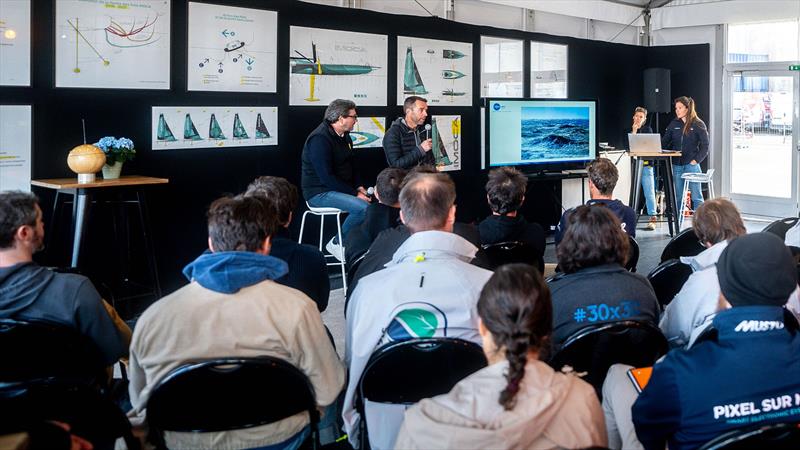
Claire Vayer: Momentum on solution-finding by MMAG is building
by Ed Gorman / IMOCA Globe Series 27 Apr 2024 06:47 BST

A meeting at The Transat CIC race village © Adrien Nivet / polaRYSE / IMOCA
Awareness and progress towards finding solutions to the problem of boats hitting marine mammals at sea is growing, according to Claire Vayer, Sustainability Manager at IMOCA.
After a meeting at The Transat CIC race village at La Base marina in Lorient on Wednesday, when the Marine Mammal Advisory Group (MMAG) briefed an audience of stakeholders, Vayer said the momentum behind this project is growing.
"My main message would be that this is a complex issue with a bunch of complementary solutions that we all have a mission to work on together, and the main point of progress is that everyone now wants to deal with it and work on it," said Vayer who, alongside Damian Foxall, former Sustainability and Program Manager at 11th Hour Racing and a coordinator of the MMAG, briefed the meeting.
"A couple of years ago there was a kind of omerta (vow of silence) on this issue," Vayer added. "But today we are reached by stakeholders in the offshore sailing world, not just in IMOCA but other classes, organisations and teams too. And the richness of this is that it also involves external organisations, like scientific bodies, that will join us to work on this."
The MMAG - the stakeholders of which include both IMOCA and 11th Hour Racing, plus World Sailing and The Ocean Race - is pursuing several approaches to trying to mitigate and reduce the instance of marine mammals being injured or killed by fast-moving racing yachts.
At the last Transat Jacques Vabre, many IMOCAs were fitted for the first time with Hazard Button technology incorporated into their navigation software. This allows skippers to alert each other and the race director in real time if they hit or observe mammals on the course. This is helping to build a database of where mammals are found which can be used by race officers to implement exclusion zones or alter racecourses to avoid areas of intense mammal activity. It is also an opportunity to gather data for scientific databases.
Both The Transat CIC and the race back to France, the New York Vendée-Les Sables d'Olonne, have courses that have been tailored by race officers to avoid mammals, in the case of the former at the finish, and the latter, at the start and elsewhere on the course.
Vayer says Hazard Button technology has huge potential. "The aim is to develop a global system," she said. "Right now we use only our software (ADRENA), but we are working on a global database which could gather information from other detection systems and from ships and other sources. Our aim is for global information sharing on collision and observations."
In parallel with work on the Hazard Button initiative, the IMOCA Class is developing the EXOS 2024 system. This combines artificial vision, multi-sensor fusion and the use of a boat's autopilot to spot obstacles on the surface of the water and ultimately respond to them through automatic collision avoidance.
"Today we don't have the exact solution that can solve the problem of underwater activity ahead of a yacht," explained Vayer. "So for now the main emphasis of work is to combine solutions and merge information in EXOS 2024. This will use information from GPS, the AIS and the thermal and optical Sea.AI camera at the top of the rig. The idea is to inform the pilot to act when it detects movement above the water and to form a new combined detection technology."
Vayer says the plan is for most IMOCA boats to have this system, which is being trialled by three yachts in The Transat CIC, in place for the start of this year's Vendée Globe in early November.